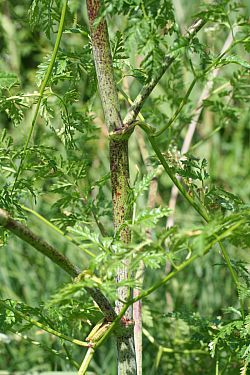Walk on the wild side
There is a shrubbery-cum-flowerbed on the west side of the North-South Road between Pevensey and Chichester that in the absence of any recent formal horticultural attention has taken itself in hand.
 David Harper (LifeSci)
David Harper (LifeSci)
 David Streeter (LifeSci)
David Streeter (LifeSci)
The result is a chaotic mix of wild and cultivated plants, the dominant feature of which is a tall luxurious crop of Hemp Agrimony.
Both its English and its Latin name, Eupatorium cannabinum, would suggest that the plant should have some affinity with Hemp. The secret of the association lies in the shape of its leaves, which bear a striking resemblance to the characteristic palmately lobed leaves of Cannabis sativa.
Some years ago the headquarters of the Sussex Wildlife Trust at Woods Mill received a visit from the police, demanding to be allowed to search the grounds. The mystery of their concern was revealed only when they discovered a clump of plants along the nature trail labelled ‘Hemp Agrimony’. An over-zealous visitor to the reserve on reading the label had reported the Trust as cultivating Cannabis!
Normally Hemp Agrimony is a plant of the tall, marginal vegetation on lakes, ponds and rivers on fertile or base-rich soils but it can also turn up on road-sides, waste ground and even on quite dry chalky banks. The pink flowers are attractive to a range of pollinating insects, especially butterflies, and give rise to the local name of Raspberries-and-Cream. Seventeenth century herbalists used it to cure almost everything!
Other conspicuous wild flowers mixed among the Hemp Agrimony are Musk-mallow, Burdock, Great Mullein, Teasel, Hemlock and Fennel.
Of these, the last two are not truly native to Britain in the sense that they arrived here either deliberately or accidentally with the help of people sometime in the past. If, as in the case of Hemlock and Fennel, this happened so long ago that the plants have in effect become a natural part of our native flora, they are now referred to as archaeophytes.
Fennel originally hails from the Mediterranean and archaeological evidence strongly suggests that it was originally brought here by the Romans and cultivated as a culinary herb. It is now a frequent plant of waste places, especially near the sea. Its finely divided leaves, distinctive liquorice smell and yellow flowers make it an easily recognised umbellifer.
 A hemlock stem showing purple spots
A hemlock stem showing purple spots
Hemlock, on the other hand, bears a superficial resemblance to several other common umbellifers such as Cow Parsley. Given that it is one of our most poisonous plants, it is sensible to know how to recognise it and any white-flowered umbellifer with purple spots on the stem and an unpleasant smell of mice should be avoided. The toxic principle consists of a cocktail of alkaloid, of which coniine is the dominant; interesting because it was the first alkaloid to be synthetically produced in the laboratory. Hemlock has been especially vigorous this year along the Lewes bypass.
